Jennifer Bohnhoff's Blog, page 46
March 15, 2015
Corned Beef: As American As Apple Pie
![By Father.Jack from Coventry, UK (corned beef selection Uploaded by Fæ) [CC BY 2.0 (http://creativecommons.org/licenses/by/2.0)], via Wikimedia Commons](https://i.gr-assets.com/images/S/compressed.photo.goodreads.com/hostedimages/1426570540i/14051965.jpg) Tuesday is St. Patrick’s Day, which means many households in America will have corned beef and cabbage stuffed into their crock-pots. Here in America, we think corned beef and cabbage is traditional Irish fare, but we are wrong. It is as American as apple pie, fortune cookies, and chow mein.
Tuesday is St. Patrick’s Day, which means many households in America will have corned beef and cabbage stuffed into their crock-pots. Here in America, we think corned beef and cabbage is traditional Irish fare, but we are wrong. It is as American as apple pie, fortune cookies, and chow mein.The word corned comes from an Old Germanic word, kurnam, which means a small kernel of something. Corned beef is beef that has been cured by packing it in barrels with coarse grains (kernels) of salt, which dried the meat out, preserving it from spoilage. The Oxford English Dictionary says that the word corned was around as early as 888 AD. Curing meat with salt is much older; there is evidence that the Greeks were dry salt curing meat by 900 BC.
Corned beef was a major industry for the Irish port cities of Cork and Dublin by sometime in the 17th century, and it continued to be their chief export until 1825. First shipped in barrels, the Irish began canning their corned beef after the process was discovered in the late 18th century. French Emperor Napoleon Bonaparte, who famously said that an army travels on its stomach, offered a cash prize to whomever developed a reliable method of food preservation. Nicholas Appert, who invented the process for sealing foods into bottles, won that prize. The Englishman Peter Durand took the process one step further and developed the process for sealing food into unbreakable tin containers. During the Napoleonic wars the British army literally lived on cans of corned beef from Cork.
But just because the Irish were producing corned beef didn’t mean they were eating it. Most Irish, if they owned a cow at all, raised it for its dairy products. Cows were sources of butter, cheese and cream and were only slaughtered and eaten when they were no longer good for milking. Sheep, too, were not often eaten, but were raised as a source of wool. Only pigs were raised for consumption. Except for those in heavily touristed areas, Irish pubs and restaurants are more likely to offer a stew of cabbage, leeks and bacon than corned beef and cabbage.
So why do we Americans associate corned beef with the Irish? One theory is that Irish immigrants in New York City found that the corned beef sold in Jewish delis was a less expensive substitute to bacon. Corned beef was a favorite, inexpensive food of the working middle class during the nineteenth century, when refrigeration was not yet widely available.
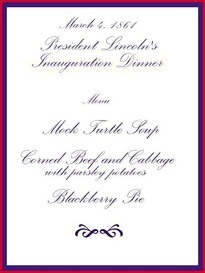 But corned beef was not just a favorite of the working man; it was also a favorite of Abraham Lincoln. In fact, the Great Emancipator chose corned beef and cabbage for his inaugural luncheon on March 4, 1861.
But corned beef was not just a favorite of the working man; it was also a favorite of Abraham Lincoln. In fact, the Great Emancipator chose corned beef and cabbage for his inaugural luncheon on March 4, 1861.Go ahead and have your corned beef on St. Patrick’s Day. Wash it down with a green beer, if you want to. And celebrate a meal that is distinctly American.
Published on March 15, 2015 19:28
February 27, 2015
Dancing With Death
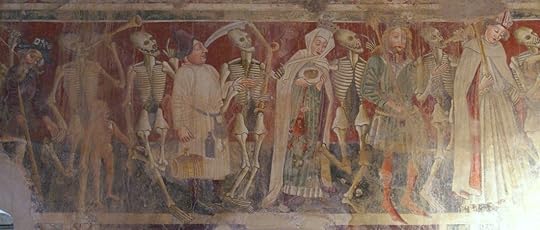 By Toffel (Own work) [GFDL (http://www.gnu.org/copyleft/fdl.html) or CC BY-SA 3.0 (http://creativecommons.org/licenses/b...)], via Wikimedia Commons When Nathan Marshal ap Tewdr, the protagonist in my new middle grade historical novel, On Fledgling Wings becomes a page for Sir Terence Newcombe, he finds that the knight is not at all what he expected. Sir Terence is paunchy, with shaggy, unkempt hair and a strange, almost staggering gait that looks as if neither foot knows where the other is headed. At dinner he fumbles with his quaking knife. He drools. He also has an irascible temper, flailing out violently when angered.
By Toffel (Own work) [GFDL (http://www.gnu.org/copyleft/fdl.html) or CC BY-SA 3.0 (http://creativecommons.org/licenses/b...)], via Wikimedia Commons When Nathan Marshal ap Tewdr, the protagonist in my new middle grade historical novel, On Fledgling Wings becomes a page for Sir Terence Newcombe, he finds that the knight is not at all what he expected. Sir Terence is paunchy, with shaggy, unkempt hair and a strange, almost staggering gait that looks as if neither foot knows where the other is headed. At dinner he fumbles with his quaking knife. He drools. He also has an irascible temper, flailing out violently when angered. Susanna the poultry woman explains that Sir Terence’s clumsiness and his temper are part of a family curse: a curse known as St. Vitus ’ Dance.
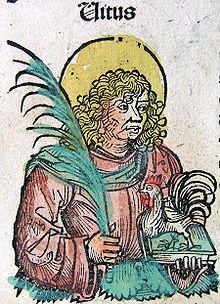 According to Christian legend, St. Vitus was a Sicilian who died in 303, during the persecution of Emperors Diocletian and Maximian. People celebrated the feast of Vitus on June 15 by dancing before his statue. This dancing became popular, and the name "Saint Vitus Dance" became connected to any malady that involved rapid, uncoordinated jerking movements of the limbs. It also led to Vitus being considered the patron saint of dancers, actors, comedians, epileptics, and, incongruously, he is said to protect against lightning strikes.
According to Christian legend, St. Vitus was a Sicilian who died in 303, during the persecution of Emperors Diocletian and Maximian. People celebrated the feast of Vitus on June 15 by dancing before his statue. This dancing became popular, and the name "Saint Vitus Dance" became connected to any malady that involved rapid, uncoordinated jerking movements of the limbs. It also led to Vitus being considered the patron saint of dancers, actors, comedians, epileptics, and, incongruously, he is said to protect against lightning strikes. No one in the Middle Ages knew about bacteria, viruses, DNA or hereditary diseases. There were no microscopes or throat swabs or blood tests to determine what ailed a body. Therefore, diseases were diagnosed purely on symptoms. It is clear to us now that the symptoms of St. Vitus Dance were caused by not just one malady, but many. Sometimes if afflicted just one person, as it afflicts Sir Terence at Farleigh. Other times, whole towns were caught up in a frenzy of jerking, erratic, frenzied behavior.
In Sir Terence’s case, the symptoms point to a hereditary disease now known as Huntington's disease. This neurodegenerative genetic disorder affects muscle coordination and leads to mental decline and behavioral symptoms. The disease begins with subtle problems with mood or cognition. This is followed by a lack of coordination and an unsteady gait. Uncoordinated, jerky body movements and mental abilities increase, often ending in dementia. Physical symptoms can begin at any age, but usually begin between 35 and 44 years of age and develop earlier at a younger age for each successive generation, a bad sign for Terence’s son Tobias.
Another disease that was once called St. Vitus Dance is Sydenham's chorea, which is most common in children. 20-30% of children who’ve had rheumatic fever will have a bout of trembling limbs six months later. The larger outbreaks of St. Vitus Dance, those in which entire towns participated, are more difficult to diagnose. Ergot poisoning, caused by a fungus that grows on, has been blamed for hallucinations and convulsions accompanying the dance mania, but not all outbreaks of St. Vitus Dance occurred during the wet growing seasons that ergot requires. Interestingly, ergot poisoning has been blamed for the hysteria of the Salem Witch Trials as well.
Other food poisonings may have contributed to some of the outbreaks. This is certainly one theory held by the sufferers themselves, who sometimes accused Jews of poisoning their wells and drove them from town in a misguided attempt to stop the malady.
Surely a few participants were hysterics, epileptics or mentally disturbed. Other modern researches have suggested that sufferers were afflicted with a mass hysteria that was more psychological in nature. Others believe that sufferers were actually participating in some cult, and that St. Vitus Dance was more akin to a Bacchanalian ritual than a malady. Perhaps all of the above is true at different places and times. The Middle Ages were a long period of time.
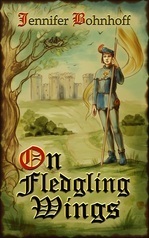 My third middle grade historical novel, On Fledgling Wings, is now available for preorder in ebook form at Amazon. If you would like to be notified when it is available in paperback, sign up for my emails.
My third middle grade historical novel, On Fledgling Wings, is now available for preorder in ebook form at Amazon. If you would like to be notified when it is available in paperback, sign up for my emails.
Published on February 27, 2015 08:49
February 8, 2015
The Right Wright
 I’m working on back material for a middle grade novel set in the thirteenth century. I’m creating a glossary because my beta readers, the kind volunteers who read my last draft of the novel, asked for it. Too many of them stumbled over words they didn’t know. Many of those words were occupational: quistron, pindar, hosteller, hayward, wainwright were a few that puzzled my readers.
I’m working on back material for a middle grade novel set in the thirteenth century. I’m creating a glossary because my beta readers, the kind volunteers who read my last draft of the novel, asked for it. Too many of them stumbled over words they didn’t know. Many of those words were occupational: quistron, pindar, hosteller, hayward, wainwright were a few that puzzled my readers.The term ‘wright’ comes from an Old English word from about 700 AD. ‘Wyrhta,” originally meant shaper of wood, but over time came to mean anyone who worked with wood, and then anyone who worked with his hands crafting something. It frequently was combined with the word for what was being crafted, creating compound words like shipwright, a person who builds ships, wheelwright, a person who builds wheels, or cartwright, a person who builds carts.
The word ‘wainwright’ is a combination of two archaic words; ‘wain,’ which is a large wagon used for farming, and ‘wright.’ While many small manors might have employed a cartwright, only a large or enterprising household would have employed a wainwright. A master wainwright would have built larger and sturdier wagons than a cartwright. His bustling shop would have employed wheelwrights, blacksmiths and painters.
The word ‘wright’ has persisted into the present predominantly as a surname. You may not know someone who works as a cartwright or a wainwright, but you may know someone who signs his name Cartwright or Wainwright. It is likely that an ancestor worked with wood or ships or wheels sometime in the distant past. Wright is the sixteenth most common surname in England.
In 1066 William the Conqueror brought the Normans into power in England, and Norman French words began infiltrating the English language which had been primarily Germanic, or Anglo and Saxon. The word ‘carpentier’ over time replaced ‘wright,’ and was gradually replaced by the simplified spelling ‘carpenter.’
By the mid-19th century, the use of wright as an occupational title had pretty much died. I can think of only one word in which it is still commonly used; playwrights are still crafting plays.
Published on February 08, 2015 13:12
January 27, 2015
The "What ifs" of History
![New York : Published by E. Anthony, 501 Broadway, [ca. 1846]](https://i.gr-assets.com/images/S/compressed.photo.goodreads.com/hostedimages/1422595379i/13522769.jpg) New York : E. Anthony [ca. 1846] In February 1861 the lieutenant colonel in command of the 2nd U.S. Calvary Regiment stationed at Fort Mason, Texas received orders to report to General-in-Chief Winfield Scott in Washington D.C. for reassignment.
New York : E. Anthony [ca. 1846] In February 1861 the lieutenant colonel in command of the 2nd U.S. Calvary Regiment stationed at Fort Mason, Texas received orders to report to General-in-Chief Winfield Scott in Washington D.C. for reassignment.When the officer's stagecoach stopped over in San Antonio, he was accosted by three secessionist army commis-sioners. Texas sided with the south, but as there had been no formal declaration of war, the policy was to allow federal soldiers to march out of the state unimpeded.
The commissioners announced that the U.S. garrison at San Antonio had already left, and that the city was under Confederate control. The lieutenant colonel must declare himself in favor of the Confederacy, or the commissioners would detain him as a prisoner of war.
The officer drew himself to attention and proudly stated that he was not a Texan, but a Virginian, and that he would decide for himself which side to take. His brave comportment must have cowed the commissioners, because they chose not to press the issue. He continued his journey eastward.
When he arrived in Washington D.C., General Scott offered the man the top field-command position in the Union Army. The lieutenant colonel declined, choosing allegiance to his state over his country.
Had those commissioners in San Antonio imprisoned that lieutenant colonel, the Civil War would have been a very different. That lieutenant colonel was Robert E. Lee, and his decision to align himself with the south profoundly affected the course of American history.
What if Robert E. Lee had moldered in a Confederate POW Camp for the entire period of the Civil War?
Such 'what ifs' are the fodder of alternative histories, those works of fiction in which events play out differently than actually happened. In these novels, the South wins the war, or slaves revolt on their own and now fight both North and South, or Europe intercedes for one side or the other. The stream of history jumps its course and nothing is as we know it.
 But not all 'what ifs' are in the realm of alternative history.
But not all 'what ifs' are in the realm of alternative history. What if you woke one day to find an enemy army camped on your property?
What if your house became a field hospital for one side, then the other?
What if your crops were trampled, your animals slaughtered and your fields littered with bloated corpses?
These were some of the questions I asked myself when I was writing The Bent Reed, my historical novel set in Gettysburg.
I found the answers in journals, memoirs and newspaper articles from the period, and in secondary sources that quoted the personal remembrances of people who had lived through the battle. I then created a fictitious family plunked their farm down right where armies would collide. I made them suffer through many circumstances that had happened to real people. The stream of history stayed in its channel and ran its course, even if it flowed over rocks that I had imagined into place.
Historical novels help readers put themselves into the swirling events of history. By reading them, we begin to ask our own 'what ifs.'
What if I were present at the Battle of Gettysburg? How would I have reacted to the violence or its aftermath? What lessons can I learn from those who have gone before me?
The answers not only help us understand the past, but help us to proceed into the future.
Published on January 27, 2015 11:41
January 22, 2015
La passione remane
 My mother gave me the necklace I am wearing today. It is one of my favorite pieces of jewelry.
My mother gave me the necklace I am wearing today. It is one of my favorite pieces of jewelry. The necklace is a chain with gray pearls. In the middle is a pendant that has a remnant of Roman glass surrounded by a silver frame on which is written Dopo il sogno la passione impressa remante.
The words are in Italian and are taken from Canto XXXIII of the Paradiso section of Dante’s Divine Comedy. Roughly translated (which is the best I can do in Italian) it says After the dream is over, the impression of passion remains.
Dante is talking about a vision of heaven and the brilliant light of God’s presence, but I think the same statement can be used to describe what happens to someone who reads and connects well with historical fiction.
A good piece of historical fiction brings with it the passion of a long-ago time and it lingers in the reader’s psyche like an impassioned memory.
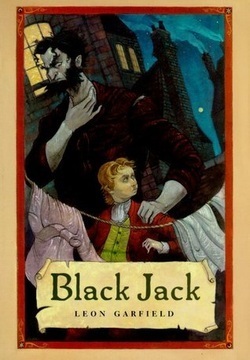 The first time I remember having a memorable encounter with an historical novel was in the fourth grade, when I picked up Black Jack, by Leon Garfield. Set in 1750, it tells the story of Bartholomew (Tully) Dorking, an apprentice who is charged with watching after the coffin of a hanged man for a Tyburn widow, the term for a woman who claims the bodies of hanged vagrants, then sells them to surgeons for experimentation. However, this hanged man isn’t dead. Black Jack has cheated death by ramming a length of pipe down his gullet. Once Tully pulls the pipe from the swarthy giant’s throat, the two embark on a journey that involves the seamiest parts of old London, a bizarre traveling circus, and the rescue of a girl from a private madhouse where forgotten lunatics are chained in empty rooms.
The first time I remember having a memorable encounter with an historical novel was in the fourth grade, when I picked up Black Jack, by Leon Garfield. Set in 1750, it tells the story of Bartholomew (Tully) Dorking, an apprentice who is charged with watching after the coffin of a hanged man for a Tyburn widow, the term for a woman who claims the bodies of hanged vagrants, then sells them to surgeons for experimentation. However, this hanged man isn’t dead. Black Jack has cheated death by ramming a length of pipe down his gullet. Once Tully pulls the pipe from the swarthy giant’s throat, the two embark on a journey that involves the seamiest parts of old London, a bizarre traveling circus, and the rescue of a girl from a private madhouse where forgotten lunatics are chained in empty rooms. I hadn’t read this book in 40 years when I found myself telling a friend about it during a long walk. I realized that imagery from the book was still floating around in my head, and I could still describe the plot in vivid detail. Later, I wondered how much I remembered and how much was just an impression of what I’d read so very long ago.
Rereading the novel, I found that whole pages jumped from my memory as if I had just read them. The lush cadence of the language and the richness of Garfield’s vocabulary came back to me. And the plot! Events followed each other masterfully, in a way that was not predictable, yet always foreshadowed. I agree with Lloyd Alexander, another of the favorite authors of my childhood, that Leon Garfield was “unmatched for sheer, exciting storytelling."
However, as much as I remembered, what I had forgotten surprised me. It wasn’t the vocabulary or the plot or the lovely flow of words that I’d forgotten, but details. For instance, a meteor shower I remembered vividly, and recalled every August when the Perseid Meteor shower came around, was actually the Northern Lights. I wonder: did my mind choose to forget that the Northern Lights were in my story because I have never seen them? Is this my mind’s way of making the story more relevant to me?
dopo il libro, l'impressione di passione rimane
Published on January 22, 2015 14:23
January 3, 2015
Finding a treasure Trove
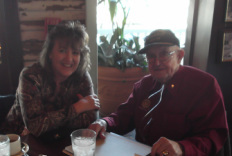 The author with John Pierucki I never expected to open a treasure trove last fall when I sat behind a table at a church craft fair.
The author with John Pierucki I never expected to open a treasure trove last fall when I sat behind a table at a church craft fair.I expected to sell a few books. Nothing more.
But then John Pierucki stopped in front of my table. He looked down at Code: Elephants on the Moon and his brow wrinkled as he asked what my book was about. When I told him that it was about World War II, he frowned a little more deeply and told me that he worked with codes during World War II, and this wasn't one of the codes.
Yes it was, I said. It was one that the Free French broadcast from London over the BBC to members of the Resistance in France. This was a code used just before D-Day.
John's eyebrows shot up. He told me that his ship had gone down on D-Day. Although he wasn't there - he had been left back in Italy - he'd lost many friends on that day.
That was it for me. I picked up a pen and signed a book to John, thanking him for his service. No one has ever done so much to earn a free book.
I met with John yesterday for lunch. He's packed a lot of life into his 90 years, and he has a lot of stories to tell. Some of them are real doozies. John served his country for 30 years as a translator and cryptographer, and he's been a lot of places and talked with a lot of interesting people.
Talking with John was like opening a treasure chest of story ideas. I'm hoping to open that chest a lot this year and run my fingers through the contents.
There's a lot of gold and precious gems in what he has to say.
Published on January 03, 2015 09:19
On Fledgling Wings ready to test its wings
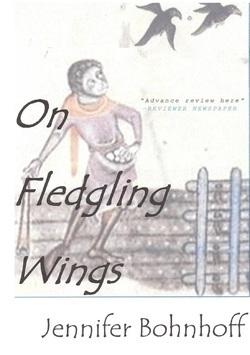 Prototype cover In my last blog post I said that I wanted beta readers for the novel I planned to publish this spring.
Prototype cover In my last blog post I said that I wanted beta readers for the novel I planned to publish this spring.On Fledgling Wings is a coming of age novel about a young boy in 13th century England. He's the coddled son of a minor knight - a big fish in a small pond - and he's a bit of a bully.
Like most boys, Nathan wishes he were somewhere else, doing something heroic. He wishes he could be like his father, who traveled with Richard the Lionheart on the First Crusade. But when he leaves home to begin his training as a page, Nathan finds that reality and the dream he's held so long don't really match up.
On Fledgling Wings is a story about finding oneself. It's about growing up and accepting the limits of one's society. And it's about accepting that some of the holes in one's heart will never be healed, but they can be filled.
Want to read On Fledgling Wings before it's published? Go to the home page of my website, fill out the form and I'll send you a coupon to get this novel for free.
Published on January 03, 2015 08:53
December 27, 2014
New Year's Resolutions
 picture courtesy of Pixabay. I understand that Christmas isn't over; the Christmas season lasts twelve days, ending on Epiphany, January 6th.
picture courtesy of Pixabay. I understand that Christmas isn't over; the Christmas season lasts twelve days, ending on Epiphany, January 6th.However, as soon as Christmas Day itself and the day after (Boxing Day to the English world and my youngest son's birthday in my little world) are over, I start to look toward the upcoming year.
I admit it now: I love to plan. Laying out how long a lesson should last, putting together a nine week plan is one of my favorite parts of teaching. Laying out a plot is one of my favorite parts of writing. And making resolutions is one of my favorite parts of the holiday season.
Resolutions for me are guideposts for where I want to go in the year ahead. I ask myself what I want to accomplish before the upcoming year turns old, who I want to be. Then I draft a list of goals that invariably would make me far thinner and smarter, my finances much more orderly, and my house sparkling clean were I to stick to my resolutions as resolutely as I should.
But life doesn't go the way I planned it to go. We have a fire drill and unscheduled assembly at school, and my nine week plan stretches to ten and a half weeks. One of my characters refuses to do what I wanted and my plot takes a twist I hadn't anticipated. I usually end the year a little smarter but not any thinner, with a pile of receipts that don't match my visa bill and more dust bunnies than I could round up in a weekend.
No problem: unfulfilled resolutions at the end of the year give me more to work on when devising new resolutions.
So here are my writing resolutions for 2015:1. I will publish On Fledgling Wings in the spring. (In order to do this I will need Beta readers. My next blog will ask you if you want to be one of the few who will get the chance to read this novel before it's published.)2. I will publish Swan Song this summer.3. I will finish Summer of the Bombers by the time I go back to school in August.4. I will begin research on a new book to write next fall.
In case you're interested, On Fledgling Wings is a midgrade (meaning for ages 10 and up) historical novel with a boy main charater. It's set in the time of Richard the Lionheart. Swan Song is a double retelling of Beowulf, with a contemporary setting and a prehistoric setting. It is a YA novel (meaning for older readers, ages 16 and up.) Summer of the Bombers is a midgrade contemporary novel about a girl whose family falls apart after a forest fire destroys her home. And the new book I want to write this fall will either be about World War I or a Civil War Battle that occured in New Mexico.
These are my plans. Hope you'll be a part of their being fulfilled.
Published on December 27, 2014 15:58
December 16, 2014
The little Depot that witnessed history
 President Street Station, Baltimore Last weekend I went to Baltimore for the Army Navy Game, a football game that has enough history to make it worth a blog post of its own.
President Street Station, Baltimore Last weekend I went to Baltimore for the Army Navy Game, a football game that has enough history to make it worth a blog post of its own.As the taxi pulled up to my hotel on President Street, I was intrigued by this little building which was across the street. It was dwarfed by the high-rises surrounding it, and looked very out of place. The building now houses the Baltimore Civil War Museum, a one room exhibit that is a mix of educational panels and curio cabinets filled with items - some identified and some not. But before it was a museum, this building was the President Street Station of the Philadelphia, Wilmington & Baltimore Railroad. Built in 1851, it was the first railroad station to have a barrel vault roof or incorporate a Howe truss, a support system more commonly used in bridge design.
But what really made this building special was not its architecture so much as the historical events that happened in it. The President Street Station was witness to a lot of Civil War history.
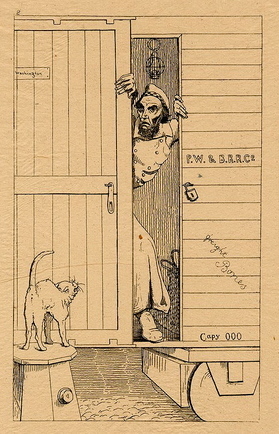 "Passage Through Baltimore" Adalbert J. Volck, 1863 On February 23, 1861 Abraham Lincoln came through Baltimore on his way to his innauguation.
"Passage Through Baltimore" Adalbert J. Volck, 1863 On February 23, 1861 Abraham Lincoln came through Baltimore on his way to his innauguation. Originally Lincoln had planned to stop and give a speech. However, warned by the Pinkerton Dectective Agency of an assassination plot, he slipped through town in the pre-dawn hours wearing a cap rather than his recognizable stove-pipe hat.
If Lincoln had chosen to brave the gangs of pro-secessionists who intended to prevent his safe passage to the capital, President-elect Lincoln might never have lived to become President.
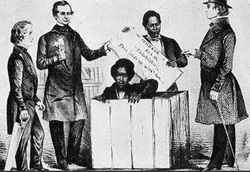 lithograph by Samuel Rowse, 1850 Lincoln wasn't the only person to hide himself in the President Street Station. Henry "Box" Brown arranged to have himself packed into a wooden crate marked "direct express to Philadelphia," and thereby escaped north to freedom from slavery. Frederick Douglas also used the PW&B line to escape, leaping onto a train as it pulled away from the President Street Station, which remains a site on the National Park Service's National Underground Railroad Network to Freedom.
lithograph by Samuel Rowse, 1850 Lincoln wasn't the only person to hide himself in the President Street Station. Henry "Box" Brown arranged to have himself packed into a wooden crate marked "direct express to Philadelphia," and thereby escaped north to freedom from slavery. Frederick Douglas also used the PW&B line to escape, leaping onto a train as it pulled away from the President Street Station, which remains a site on the National Park Service's National Underground Railroad Network to Freedom.
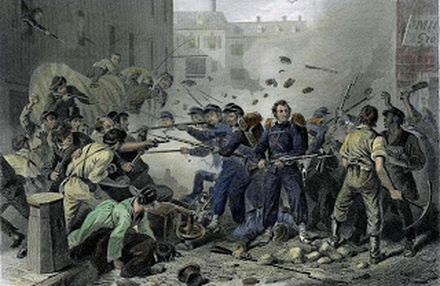 "Massachusetts militia passing through Baltimore," oil on Canvas (1861). The event that the President Street Station is best remembered for happened two months after Lincoln's secretive trip through Baltimore.
"Massachusetts militia passing through Baltimore," oil on Canvas (1861). The event that the President Street Station is best remembered for happened two months after Lincoln's secretive trip through Baltimore.Most people consider the Confederate attack on Fort Sumter on April 12, 1861 as the beginning of the Civil War, but the first blood was spilled on April 19, 1861, when the 6th Massachusetts Infantry, debarking at the President Street Station enroute to Washington D.C. were accosted by southern sympathizers who blocked their path and pelted the soliders with rocks and bricks. By the end of what became known at the Pratt Street Riots, four soldiers and nine civilians lay dead in the streets.
For a first hand account of the Pratt Street Riot, click here.
Published on December 16, 2014 20:15
December 8, 2014
Proud Loser
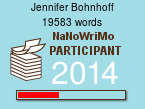 November was National Novel Writing Month, and like scads (a technical term for a lot, but less than Carl Sagan's billions and billions) of crazy writers, I attempted to write a novel in a month.
November was National Novel Writing Month, and like scads (a technical term for a lot, but less than Carl Sagan's billions and billions) of crazy writers, I attempted to write a novel in a month.I could have done it, too. I was pretty close to right on course: a few too few words some days, a few too many on others. Never so behind that I couldn't catch up.

 And then something happened. Specifically, Thanksgiving happened. And instead of spending my spare time battering the keyboard, I chose to spend it with family. Together with my husband, my oldest son, his wife and daughter, I flew to Pittsburgh. We stayed just down the street from my middle son, his wife, and their month-old daughter. My youngest son drove in from West Point, bringing another cadet with him.
And then something happened. Specifically, Thanksgiving happened. And instead of spending my spare time battering the keyboard, I chose to spend it with family. Together with my husband, my oldest son, his wife and daughter, I flew to Pittsburgh. We stayed just down the street from my middle son, his wife, and their month-old daughter. My youngest son drove in from West Point, bringing another cadet with him.I spent the last five days of November holding a baby, watching a toddler entertain her uncles (and vice versa), cooking big pots of New Mexican posole and stews, and reconnecting with the people who mean the most to me.
And my NaNo graph flat lined.
I'm usually a very driven person, and it's hard for me to let go of a goal, but sometimes it's worth it. Someday one of my novels might bring me a large piece of immortality, but my children and my grandchildren will definitely bring me my own, personal piece of tomorrow.
Now it's December and NaNo is irretrievably gone. My new project for the new month was joining a Crossfit gym on a special $21 for 21 days deal. If I stick with this for all 21 days I'll being doing as well as I did at NaNo. And maybe at the end of the month I will be able to report that, for the second month in a row, I am a proud loser.
Published on December 08, 2014 09:05



